Via spins Em-ITX expansion modules
Apr 15, 2010 — by LinuxDevices Staff — from the LinuxDevices Archive — viewsVia announced three expansion boards designed to work with devices employing its Em-ITX form factor. The EMIO-3110, EMIO-3210, and EMIO-3430 respectively add “advanced graphics and video processing,” multiple serial and parallel ports, or GPRS, WiFi, and Bluetooth, the company says.
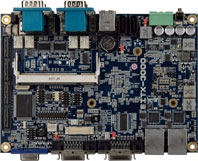 Via released its 6.7 x 4.7-inch Em-ITX format in March 2009, billing it as an "open industry standard." Not long after, the company announced the EITX-3000 (left), which supports Via's Nano or Eden CPUs, and remains the only Em-ITX board we've heard of.
Via released its 6.7 x 4.7-inch Em-ITX format in March 2009, billing it as an "open industry standard." Not long after, the company announced the EITX-3000 (left), which supports Via's Nano or Eden CPUs, and remains the only Em-ITX board we've heard of.
A key advantage of Em-ITX is said to be the form factor's rectangular shape (below), providing dual "coastlines." This provides 19 percent more room for real-world connectors than if a square had been utilized, Via says. Another benefit touted by Via is Em-ITX's "Em-IO" expansion bus, capable of supporting optional add-on modules.
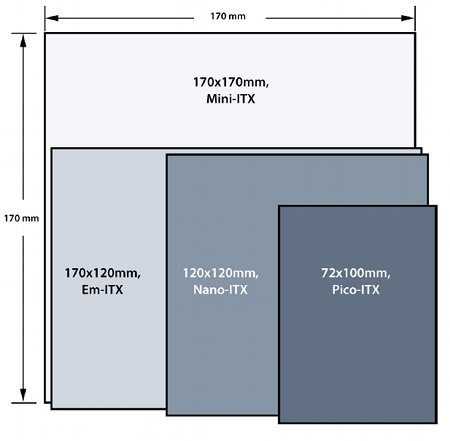
Em-ITX is 30 percent smaller than Mini-ITX, but has twice the coastline
(Click to enlarge)
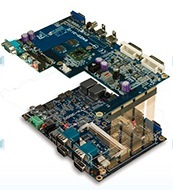 Via's newly announced EMIO-3110, EMIO-3210, and EMIO-3430 appear to be the first such modules to have been produced. As shown at right, they snap onto the EITX-3000's expansion connector and stack horizontally on top of the main board. Since Em-IO does not include any pass-throughs, however, only one module may be installed at a time, or so it would appear.
Via's newly announced EMIO-3110, EMIO-3210, and EMIO-3430 appear to be the first such modules to have been produced. As shown at right, they snap onto the EITX-3000's expansion connector and stack horizontally on top of the main board. Since Em-IO does not include any pass-throughs, however, only one module may be installed at a time, or so it would appear.
EMIO-3110
Via describes the EMIO-3110, pictured below, as an "instant digital signage solution." The module includes an S3 4300E GPU (graphics processing unit), 256MB of DDR3 memory, two HDMI ports, two DVI ports, a VGA output, and an optional TV output, the company says.
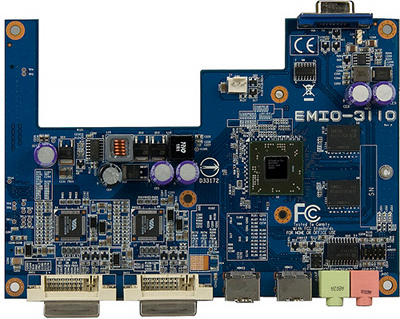
Via's EMIO-3110
(Click to enlarge)
According to Via, when the EMIO-3110 is employed with the EITX-3000, the latter's VGA port also remains usable. Therefore, the solution provides support for up to six displays, four of which can be showing different content, the company says.
Via says the EMIO-3100 provides hardware acceleration for H.264/AVC, MPEG-4, MPEG-2, AVS, and VC1, though no information was provided about maximum resolutions or frame rates for video. Still images may be up to 2048 x 1536 pixels, while the module supports DirectX 10.1 and also offers a microphone input and line output, the company adds.
EMIO-3210
Via's EMIO-3210, pictured below, is said to target factory automation and customer service kiosks. The module includes a Fintek F81865 I/O controller, adding eight different ports to the EITX-3000.
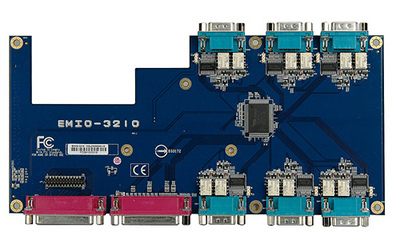
Via's EMIO-3210
(Click to enlarge)
The EMIO-3210 has two 25-pin parallel ports, Via noting that LPT1 is supported by a F81865 that's already present on the EITX-3000, while LPT2 is supported by the secondary F81865 the module adds. The module also has six RS232/422/485 ports, spread over its north and south coastlines, Via says.
EMIO-3430
Via says the EMIO-3430, pictured below, is designed to add a PC card slot, GPS receiver, Bluetooth, and wireless networking to Em-ITX devices. With a Ricoh RSC803 PC card controller and slot as standard, the module is ready to accept either 32-bit CardBus or 16-bit PCMCIA cards, according to the company.

Via's EMIO-3430
(Click to enlarge)
GPS, Bluetooth, and WiFi do not come with the module, but Via says it has paved the way for them by providing a UART controller (for GPS) and a four-port USB 2.0 controller (for WiFi and Bluetooth), plus sockets for the relevant devices. The add-ons, all of which may be installed simultaneously, are:
- The EMIO-1530, which supplies 802.11b/g wireless networking
- The EMIO-1531, which supplies Bluetooth via a Qcom QBT400UB core
- The EMIO-1532, which provides GPS via a Leadtek GPS receiver that employs the SiRF starIII chipset
According to Via, the EMIO-3430 also includes 3.5mm jacks for a microphone input, a line input, and a speaker output. The EITX-3000 itself already provides audio I/O, but only via pin headers, the company says.
Availability
Via's EMIO-3110, EMIO-3210, and EMIO-3430 appear to be available now. More information may be found on the company's website, here, here, and here, respectively.
This article was originally published on LinuxDevices.com and has been donated to the open source community by QuinStreet Inc. Please visit LinuxToday.com for up-to-date news and articles about Linux and open source.